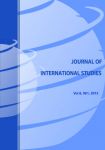COMPETITIVENESS OF UZBEK AGRARIAN FOREIGN TRADE – DIFFERENT REGIONAL TRADE BLOCS AND THE MOST SIGNIFICANT TRADE PARTNERS
COMPETITIVENESS OF UZBEK AGRARIAN FOREIGN TRADE – DIFFERENT REGIONAL TRADE BLOCS AND THE MOST SIGNIFICANT TRADE PARTNERS
Author(s): Akhmadjon Ortikov, Luboš Smutka, Irena BenešováSubject(s): Geography, Regional studies, Agriculture, International relations/trade
Published by: Fundacja Centrum Badań Socjologicznych
Keywords: agrarian trade; agricultural products and foodstuffs; Uzbekistan; partners; competitiveness; changes; institutional comparative advantage; balance; products mapping;
Summary/Abstract: Agriculture is one of the leading and largest economic sectors in the nation of Uzbekistan. The share of employees in the agricultural sector is 33% of the population. The annual growth rate of the agricultural sector is 1.7%, and it accounts for 18% of GDP. Agriculture provides jobs for approximately 15 million people, many of whom are part-time workers. During the years 2000 – 2018, the value of agrarian trade turnover increased from cc 520 million USD to 2.8 billion USD. This paper examines Uzbek foreign trade in agricultural products from the following perspectives: trade balance of Uzbekistan and international competitiveness. The intention of the paper is to determine changes in the character of agricultural trade. Changes in the product structure are identified, and individual changes are explained. The comparative advantages are analyzed according to different groups of countries (Asian countries without CIS countries, CIS without Asian countries, EU28 without other European countries, other European countries without EU and CIS countries, and developing countries). Agrarian trade competitiveness and territorial and commodity structure changes are analyzed for the last 19 years (2000–2018). The commodity structure of agricultural trade is analyzed on the basis of the standard Harmonized System. The source of information in the article is UN COMTRADE. The analysis is based on the following method and indexes: “product mapping approach” method, Herfindahl-Hirschman index, Lafay index, and the trade balance index. In addition, some other statistical characteristics are applied: geomean, chain index, basic index, import/export coverage ratio, etc. Uzbek agricultural exports are competitive with regard to Asian and CIS countries, and limited when compared with other territories.
Journal: Journal of International Studies
- Issue Year: 12/2019
- Issue No: 4
- Page Range: 177-194
- Page Count: 18
- Language: English

